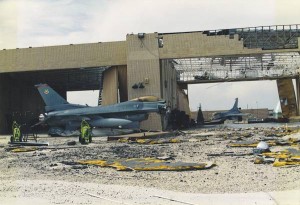Climate Change and U.S. Military Bases
Climate change will not only affect American security through impacts on the economy and our physical infrastructure (roads, bridges, airports, etc.); it can also affect our domestic and international military bases. Physical changes to the environment such as flooding, drought and extreme weather events may disrupt U.S. military capabilities and facilities, including military training ranges and bases.
According to the U.S. Department of Defense, there are a number of US military installations that are already at risk. The report states: “The National Intelligence Council [NIC] judged that more than 30 U.S. military installations were already facing elevated levels of risk from rising sea levels. DoD’s operational readiness hinges on continued access to land, air, and sea training and test space.”

Homestead AFB after Hurricane Andrew.
Although sea-level flooding remains a major concern for the security of U.S. military bases, a variety of other environmental threats pose serious risks as well. In September 2018, Marine Corps’ Camp Lejeune was severely damaged by Hurricane Florence and subsequent flooding of the state. Estimates suggest that recovery will cost $3.6 billion. Only a month later in October 2018, Tyndall Air Force Base was hammered by Hurricane Michael. Previously home to many of the Air Force’s F-22s, rebuilding will likely take years and cost upwards of $4.5 billion. The damage to these bases undermine the readiness of our fighting forces, diverting resources and attention away from the mission. In addition, military bases in the U.S. are important for driving local economies and when they are destroyed by natural disasters, there is a ripple effect economically in the region.
According to a Department of Defense Report, the United States military manages property in all 50 states, 7 U.S. territories and 40 foreign countries, comprising almost 300,000 individual buildings around the globe. These buildings are valued at $590 billion. The Army alone has over 14 million acres of property, 2000 installations and 12,000 historical structures. As the effects of climate change increase in many parts of the world, our investments and structures may be at risk of severe damage. Worryingly, recent studies have found that the military is not prepared to meet this threat.
The physical and operational security of U.S. military bases around the world is a vital requirement to maintaining the national security of the United States and stability abroad. For example, the island of Diego Garcia in the Indian Ocean is a critical logistics hub for U.S. and British forces in the Middle East and houses critical Air Force Satellite Control Network equipment. It is one of our most vulnerable military installations and one of the most important for our national security. Climate change is a threat to the United States and it must begin to confront those potential impacts on its military installations and missions around the world.
Required Report to Congress on Climate Vulnerability
From sea level rise to droughts, wildfires, and floods, each base has unique vulnerabilities. The Department of Defense must prepare for the coming changes by investing in both low-cost short-term solutions, and long-term adaptation strategies. The 2018 National Defense Authorization Act (NDAA) outlines these threats and directs Secretary of Defense Mattis to submit a report within one year on the,
“vulnerabilities to military installations and combatant commander requirements resulting from climate change over the next 20 years. (including) A list of the ten most vulnerable military installations . . . based on the effects of rising sea tides, increased flooding, drought, desertification, wildfires, [and] thawing permafrost”
This interactive map highlights some of the most strategically important military installations that are vulnerable to the effects of climate change. Each installation on the map includes information on the threat horizon, type of threat, strategic significance, and specific projections of the impacts the installation could experience in the future. While not comprehensive, we believe this map provides a starting point for analysis.
Key:
Installations that appear blue on the map are those threatened by sea level rise and flooding, ones in red are threatened by excessive heat, orange designates drought and wildfire threat, green is flash flooding, and brown is coastal erosion. Each installation is categorized by the primary threat it faces, but that does not mean that bases face only one type of threat.
Further Resources:
ASP Climate Security homepage
2012 Climate Security Report
Fact Sheet on Military Basing and Climate Change
Op-ed in Stars and Stripes about the threats posed by climate change to strategic bases
UK Bases at Risk from Climate Change
2017 Congressional Action Affirms Climate Security Risk, Asks Military to Prepare
How Climate Change Threatens Guam in the Long Term







